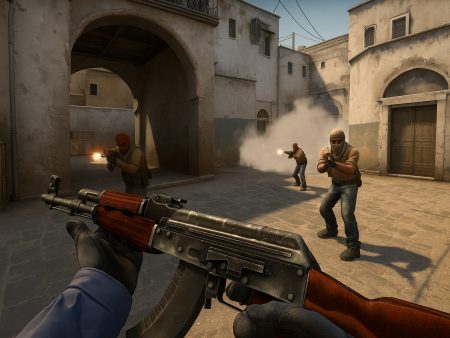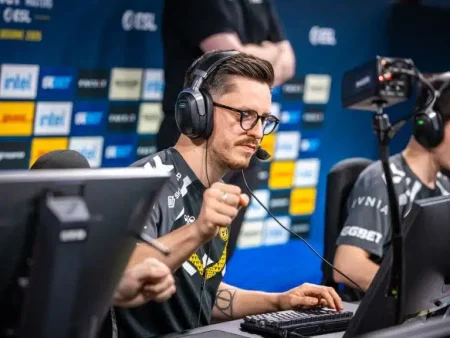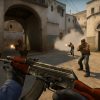Master the CT side in CS2 with this in-depth guide covering rotations, site holds, utility usage, and advanced tactics. Improve your defensive gameplay, communication, and map control to dominate every match.
When you’re playing the Counter-Terrorist (CT) side in CS2, your job isn’t just to stop the bomb plant—it’s about control, communication, and consistency. CTs are the defensive side of the game, and while that might sound passive, it couldn’t be further from the truth. You’re not just waiting around for the enemy; you’re making proactive decisions to control territory, gather information, and rotate smartly.
The CT side is all about precision. One mistake—like peeking alone without support or rotating too early—can cost your team the entire round. The biggest difference between good and great CT players? Great CTs understand timing and pressure. They know when to hold, when to fight, and when to back off and wait for their team.
It’s also a mindset. CT players have to think two steps ahead. What does the enemy want? What did they do last round? What utility did they throw early? All of these questions help shape your decision-making throughout the round.
If you want to win games consistently in CS2, mastering the CT side is non-negotiable. It’s where teamwork shines, where smart plays win rounds, and where solid fundamentals separate the ranks.
Key Objectives of the CT Side
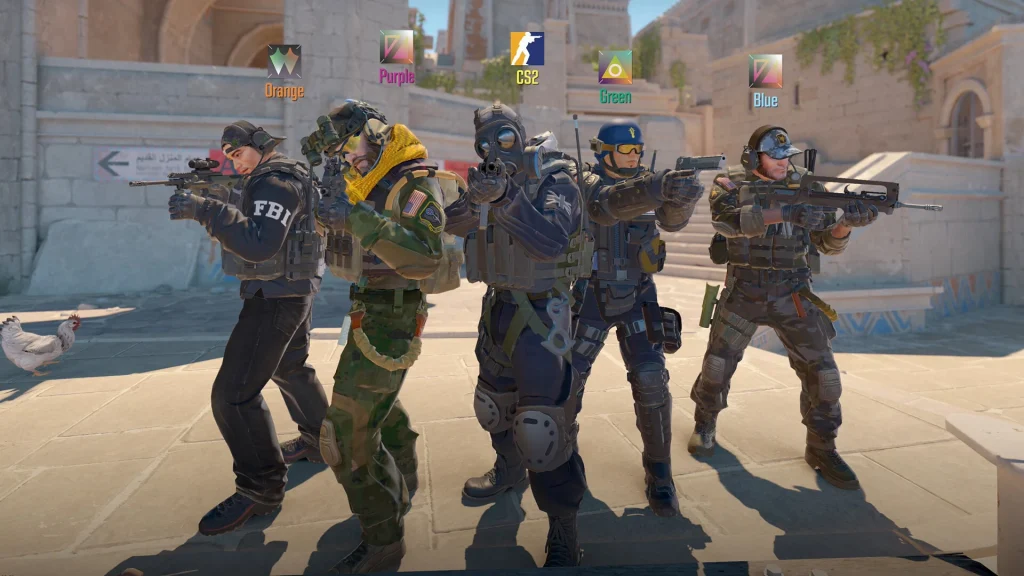
CTs have several primary objectives that guide how they play the round. Let’s break them down:
- Deny map control – This means preventing Ts from taking key areas like mid, banana, or short. Use utility, aggression, or crossfires to keep them at bay.
- Hold bombsites – Sounds obvious, but holding isn’t just sitting there. You need to delay pushes, call for rotations, and ideally, survive until help arrives.
- Gather information – A CT team without info is like playing blindfolded. If no one’s watching mid or pushing for info, you’re gambling.
- Efficient rotations – Moving from one site to another is the heartbeat of a good CT half. Get this wrong, and you’ll either arrive too late or leave your site open.
- Retake smart – If you lose a site, it’s not the end. But rushing in without coordination or utility is a waste. Retake as a unit, or save if the odds are too low.
In essence, playing CT side is a balancing act between passive defense and proactive map control. You’re constantly reading the enemy, adjusting your position, and relying on your teammates.
Map Control and Early Round Strategy
Why Early Map Control Matters
Early round map control on the CT side is where you set the tone. The first 15 seconds of a round often decide how the rest plays out. If you give up control too easily—like letting Ts walk up mid or push into banana without contest—they’ll be free to execute their strat without pressure. That’s a recipe for disaster.
Let’s take an example on Inferno. If you don’t contest banana, the Ts take it for free. Now they can throw full executes, lurk behind smokes, or even double back to A while you’re left guessing. But if you use a well-timed molly, a flash, and have two players peek for banana control, you gain info and can rotate your B player earlier if needed.
Early map control doesn’t mean over-peeking, though. You’re not looking to frag every round—you’re looking to delay, deny, and decide. Delay their pushes, deny their comfort, and decide how your team will respond.
Here are some key tools for early control:
- Molotovs to delay or block rushes
- HE grenades to punish grouped Ts
- Flashes for safe peeks and regains
- Aggressive set plays (like pushing short with a teammate)
You want to make the T side guess. Are you playing deep? Are you pushed up? Do they need to waste utility early? Keeping them uncomfortable is the name of the game.
Common CT Openings and Grenade Usage

Different maps have different CT openings, but there are some patterns and principles that carry across them all. A strong CT side is built on coordinated utility and positioning.
Let’s take Dust2 as a case:
- Long control: One CT spawns and throws a fast long smoke; another tosses a molly to slow the T push, and both peek with a flash.
- Mid to B hold: One player anchors B, another watches mid from CT or car. They use flashes to keep Ts honest and not rush mid-split.
Smart nade usage early can buy you 10–15 seconds, and that’s everything. Each second the Ts wait gives your team time to rotate, regroup, and prepare. Want to hold A site on Mirage? Don’t just sit in CT spawn—use a jungle smoke, short molly, or push ramp with a teammate and trade.
Here’s a general tip: Don’t waste utility just because the round started. Use it based on audio cues or known timing. For example, a molly into apartments at 0:10 might hit a rushing T perfectly—while using it at 0:00 does nothing.
Want more specifics? We’ll break down map-based utility later in the article.
Site Anchoring: Holding Down Bombsites
The Role of the Anchor
Anchoring is one of the most demanding and critical roles on the CT side. Anchors are the last line of defense—your job is to hold a bombsite alone or with minimal help, delay enemy advances, and ideally get a frag or two before falling back or dying. It requires nerves of steel, discipline, and excellent game sense.
Let’s get one thing straight: being a good anchor isn’t about getting flashy 3Ks every round. It’s about playing smart, wasting time, using utility perfectly, and buying your team time to rotate. If you can delay the T-side push for even 7–10 seconds, you’ve done your job.
Think about anchoring on B site in Mirage. You may have one teammate helping you early on with utility, but mid to late round, you’re often solo. It’s your job to throw a well-timed smoke, use a molly when you hear steps or flashes, and not panic when the execute comes.
Here are the key traits of a strong anchor:
- Consistent communication – Let your team know what you see and hear in real-time.
- Smart utility usage – Don’t waste your smoke 10 seconds into the round. Wait until you hear footsteps or see the first flash.
- Strong crosshair placement – Expect common entry points and hold smart angles.
- Good fallback plans – Have a smoke or flash to fall back behind cover when overwhelmed.
Anchors must be unselfish. You’re not always in the highlight reel, but you’re often the reason your team wins the round. You’re the one stalling the push, damaging opponents, and setting your teammates up for a clean retake.
Best Spots and Setups for Holding A and B
Where you position yourself as an anchor matters more than most players realize. The wrong angle leaves you exposed or gets you cleared with pre-aims or utility. The right spot buys you time, gets easy kills, or lets you escape unharmed.
Let’s talk setups:
On Mirage:
- B Site Anchor – Play van early, but fall back to bench or jail after your utility. Use your molly for apartments and a smoke for the window or site. Alternate between passive and aggressive positions so Ts can’t predict you.
- A Site Anchor – Under balcony is strong with good aim, but use it sparingly. Playing from triple or CT lets you delay with utility and fall back safely. Combine your setup with a teammate in jungle or connector for crossfire.
On Inferno:
- B Site – Play new box or second oranges with a smoke ready. Molly banana early. Use sound cues to flash your teammate in banana or delay executes.
- A Site – Pit is your best friend. It offers safety, cover, and kill potential. Mix between pit, mini-pit, and site boxes depending on round.
Tips for effective positioning:
- Change positions often – Don’t play the same angle twice in a row.
- Think of escape routes – If you miss a shot or spot a rush, can you fall back?
- Play off your teammate’s utility – Combine your flashes and smokes for layered defense.
Positioning is chess, not checkers. Don’t just hold W and hope—they will punish predictable plays.
Surviving and Falling Back Without Dying
One of the most underappreciated CT skills is knowing when not to take the fight. If three Ts are rushing you with full utility and you’re alone with a rifle, what’s your best move? Delay, don’t duel.
Here’s how to fall back smartly:
- Use a defensive smoke – Drop a smoke at the choke point (apps, ramp, banana) and fall back behind cover.
- Flash and reposition – Toss a flash behind you as you retreat. Most Ts won’t push through a white screen.
- Don’t over-peek – Get your info and reposition. A free kill isn’t worth dying and leaving your site open.
- Call rotations early – If you hear multiple steps and flashes, alert your team. Don’t wait until they’re on-site.
Your survival often leads to round wins. If the Ts plant but you’re alive with a teammate, you’ve got a good shot at a retake. Dead anchors = free sites. Live anchors = pressure.
Train yourself to value life more than ego. Being alive with 40 HP and a flash is better than dying for one kill.
Effective Rotations: When and How to Move
Reading the Game and Making Smart Rotations
Rotating on the CT side is like solving a constantly changing puzzle. You’re balancing incomplete information, map pressure, and time. Rotating too early leaves a site vulnerable. Rotating too late means arriving when it’s already over.
Good CTs don’t rotate just because they hear footsteps. They rotate based on:
- Utility usage (Is that a fake or a real execute?)
- Info from teammates (Is anyone watching mid or flanks?)
- Patterns from previous rounds (Did the Ts fake A twice already?)
Here’s a general rule: don’t rotate unless you’re sure the hit is coming. A single flash or molly doesn’t mean the whole team is there. Smart Ts will fake utility to bait your rotations. If you fall for it, you’re leaving a site wide open.
The best rotations are fast, silent, and timely. Use the map to your advantage:
- Mirage CT rotates through jungle and market
- Inferno rotates through CT spawn and speedway
- Nuke rotates through vents and secret
Mastering your map’s geometry helps you shave seconds off your rotation—seconds that win rounds.
Communicating Rotations Clearly
Every CT rotation should come with a clear callout. Confusion leads to gaps, and gaps lead to free site takes.
Example:
- “I’m leaving B, stacking A.”
- “I’m going CT to rotate. Hold jungle.”
- “Smoke mid, might be a fake. Don’t leave A yet.”
Communicate not just that you’re rotating, but how and why. If you’re falling back from banana on Inferno, tell your teammate you’re smoked off or saw multiple. Let them adjust their play accordingly.
Also, don’t all rotate at once. One player should always anchor the second site unless you’re absolutely certain it’s a full commitment. If you leave B and they walk out apps, it’s your fault.
Avoiding Over-Rotating and Gaps in Defense
One of the most common CT mistakes is over-rotating. You hear one flash at A and suddenly everyone’s sprinting over, leaving B wide open.
Here’s how to avoid that:
- Designate a rotator – One player plays between sites (like connector or arch) and acts as a fast support. Others hold firm until called.
- Trust your anchor – If they say “I can delay,” don’t panic rotate. Let them play.
- Use utility to delay commitment – A well-placed smoke can buy 15 seconds, plenty of time to hold a rotation.
Think of the CT side as a fortress with gates. If you leave one open too soon, the enemy walks in unchallenged. Good CT teams rotate with discipline and trust.
Utility Usage on CT Side
Smoke, Flash, and HE Usage in Holds
On the CT side, your utility is your best friend. You don’t have the luxury of planning full executes like the T side, but well-timed defensive utility can win rounds by itself. If you’re just tossing your smokes and flashes at the start of the round without a plan, you’re doing it wrong.
Let’s break down each type of utility and how you should use it when holding a site:
Smokes – These are for denial and delay. A smoke thrown at the right time can prevent a rush, stop an execute, or force Ts to waste more utility. Don’t just throw your smoke immediately at the start of the round. Instead, hold onto it and throw it when:
- You hear rushing footsteps.
- You see the first flash or molly coming in.
- You’re getting overwhelmed and need to reposition.
A good CT player gets maximum value out of one smoke. For example, smoking off banana at 1:20 is far more effective than at 1:50 if no one’s there.
Flashes – These are your tools to fight back. Use flashes to peek angles, help teammates retake space, or escape from a push. A good flash can blind multiple Ts and buy you several seconds.
Key flash tips:
- Learn “pop flashes” that explode instantly in common chokepoints.
- Use flashes to help your teammates re-aggress areas like mid or banana.
- Keep one flash for retake or escape—don’t use everything early.
HE Grenades – Underused but deadly when timed correctly. A single HE can do 30–50 damage to grouped Ts, especially on rushes. Think of HE grenades as area denial for early map control or bomb plants.
Example: On Inferno, if Ts are banana-heavy, an HE at logs can do massive damage. Same for apartments on Mirage—lob an HE when you hear them grouping for a pop.
Proper utility usage isn’t just about throwing grenades. It’s about throwing them with intent, and more importantly, not throwing them until you have to.
Best One-Ways and Smokes on Key Maps
Let’s look at some of the most effective and popular one-way smokes and key smokes for CTs on common maps:
Mirage
- Jungle one-way: Smoke top connector but stand in jungle close to the smoke. You see mid—Ts don’t see you.
- Ramp smoke from CT: Easy smoke to block a fast A push.
- Mid window smoke: If the Ts don’t throw it, your AWPer or rifler has a huge advantage.
Inferno
- Banana half-wall smoke: Use to retake control mid-round or delay a push.
- CT one-way at coffins: Gives vision toward banana while hiding most of your model.
- Apps window smoke: Throw from pit or arch side to block Ts from peeking deep apartments.
Overpass
- Monster smoke from A: Can be thrown by a rotator to help delay B rushes.
- One-way at short B: Smoke near the barrels, crouch behind it—great for cheeky kills.
- Long A smoke: Stops Ts from taking bathroom control too quickly.
Practice these smokes in offline servers and know their lineups like the back of your hand. Every second a good smoke buys is an opportunity for you to rotate, set up, or stop a push entirely.
Retaking Sites with Coordinated Utility
You’ve lost the site. The bomb’s down. Now what? If you still have teammates alive and some utility, a well-coordinated retake can easily turn the round in your favor.
The biggest mistake in CT retakes is rushing in one by one. It’s the classic “solo hero” syndrome, and it never ends well. Instead, approach retakes like this:
- Wait for your team – Unless you’re flanking or have a guaranteed kill, don’t go alone. Teamplay is everything.
- Clear common angles with flashes – Don’t dry peek CT on A site or banana on B. Flash first!
- Use smokes to cut off sightlines – Need to defuse? Smoke the bomb and get a teammate to stick while you cover.
- Communicate roles – “I’m flashing CT,” “I’ll clear site,” “I’m defusing, cover me.”
Even something as simple as a flash + smoke combo can win a round. Don’t waste it in panic. Use it with a plan.
Smart CTs always keep one flash or smoke for the retake—especially in 3v3 or 2v2 scenarios. That one grenade can be the difference between a lost round and a clutch.
Mid-Round Decision Making
How to Adapt Based on Enemy Behavior
Mid-rounds are where games are won and lost. It’s no longer about executing a strategy—it’s about adapting to what the Ts are doing in real time. Smart CTs pick up patterns and adjust mid-round to exploit them.
Here’s what to look for:
- Do they always fake A before going B? Rotate slower next time.
- Are they sending lurkers late through mid or connector? Hold your flank longer.
- Is their AWPer posted mid every round? Avoid peeking, change angles.
Adaptation is about information and trust. If your A anchor says “no presence ramp or palace,” then they’re likely leaning B. That’s a green light to rotate your mid player or float toward B site.
You also need to think like a T. If you were them, what would you do next? If they’ve had success on A two rounds in a row, would they go B now to mix it up? Or keep pushing what works?
Always be one step ahead. Play the chess match, not just the aim duel.
Using Sound and Info for Smart Mid-Round Plays
Sound is an underused tool in mid-rounds. Footsteps, scopes, utility pulls—all of it gives you clues without giving away position.
Some examples:
- Hear a scope toward mid? That’s likely an AWP—avoid challenging.
- Hear jumping in apps but no utility? Could be baiting noise for info.
- Hear the bomb rotating through T-spawn on Dust2? Time to adjust your setup.
Use info to make plays:
- Push for info on the opposite side of the map if your teammate hears steps on their site.
- Aggressively peek mid if you know Ts are committed to B.
- Flank silently if you know they’re hitting A with 3 players.
Don’t just hold angles passively. Sound gives you permission to act when the enemy thinks you won’t.
Timing Your Rotations in Mid to Late Round
Mid to late round is when CTs must rotate decisively—not hesitantly. You don’t always get a second chance. If you’re late, the site’s already lost. If you’re early and it’s a fake, the other site’s gone.
The best CT players time their rotations based on:
- Confirmed info (bomb spotted, multiple players seen)
- Utility usage (flashes, mollies, smokes)
- Loss of map control (e.g., mid is given up without contest)
Also, watch the clock. If there are 20 seconds left and you haven’t seen the Ts commit, don’t panic. They either hit a site now or lose the round. That’s a perfect time to gamble stack or anchor tightly.
Mastering rotation timing takes time. You’ll misread rounds at first. But with experience, you’ll learn to “feel” when the hit is coming—and move just in time to stop it.
Playing as a Team: Communication and Trust
Creating Strong Site Duos and Trios
The CT side isn’t about lone wolfing—it’s about duos and trios that play off each other perfectly. Strong pairings on bombsites can turn even the scariest executes into meat grinders. The magic happens when you understand not just your position, but your teammate’s as well.
Let’s break it down:
- On Mirage A site, one player can play under balcony while the other anchors CT or triple. The under player gets early info and delays, while the CT player flashes and re-peeks for trades.
- On Inferno B, one plays coffins or new box while the other plays close banana. If Ts rush, the close player gets one and falls, the other drops utility or peeks from a safe angle.
You and your duo should always ask:
- “What’s our plan if they rush?”
- “Who’s peeking first?”
- “Who’s got utility?”
- “What’s our fallback route?”
It’s also important to mix up your setups:
- Crossfires (you peek one angle, they peek another)
- Layered defenses (one close, one far)
- Aggressive fights (double push ramp or apps)
On larger maps like Overpass or Ancient, trios become more common. You’ll see a B site hold with one pillar, one short, one water. Or on Nuke, players in heaven, site, and ramp.
Synergy and spacing matter more than firepower. Duos who trade kills consistently and trust each other will win more rounds than five solo queue heroes with god aim.
Callouts That Prevent Panic Rotations
Clear and concise communication can be the difference between a clean hold and a total collapse. If you’re vague or panicked in your callouts, your teammates won’t know where to help—or if they should rotate at all.
Examples of bad callouts:
- “They’re A! They’re here! They’re pushing!”
Examples of good callouts:
- “Three ramp, no palace. I’m smoking ramp now.”
- “Apps clear. Holding short. One boiler.”
- “Mid smoked. One top mid seen. Could be fake.”
Every callout should give at least one of these:
- Enemy position
- Number of enemies
- Utility or movement
- Your status (falling, staying, fighting, rotating)
Also, share when you’re rotating off a site:
- “Leaving B. Rotating CT. You’re alone A.”
- “I’m flanking banana—wait for my push.”
This builds trust, avoids over-rotations, and ensures the remaining players know exactly what’s happening. Communication = control.
Understanding Roles Within a CT Setup
Not everyone on the CT side has the same job. Some players are anchors, others rotators, and some are supports. Knowing your role helps you make smarter decisions, especially when things get chaotic.
Here are common CT roles:
- Anchor: Holds the site, delays pushes, rarely rotates early.
- Rotator: Floats between sites, supports with utility, peeks mid-round.
- AWPer: Controls long sightlines (mid, long, CT spawn), supports rotations.
- Support: Tosses utility for aggressive plays, plays close to anchors.
- Lurker (rare on CT, but you might be an info-gatherer): Pushes for map control when needed.
Each role has responsibilities:
- Anchors don’t rotate without a call.
- Rotators must respond quickly and communicate clearly.
- AWPers need to reposition often and avoid early deaths.
- Supports watch flanks and throw lifesaving nades.
If you’re all playing like AWPers or solo fraggers, your CT side will collapse. Know your job. Play to win the round, not the highlight.
Eco Rounds and Force Buys on CT Side
How to Hold with Pistols and SMGs
Eco and force buy rounds are your chance to steal a round from a full-buy team—and it happens more often than you think. With good positioning, teamwork, and cheeky plays, CTs can shut down even full AK rushes with just pistols and SMGs.
On eco rounds:
- Stack a site—especially if you’re losing or low on info.
- Play close corners—use shotguns or pistols where Ts have to check multiple angles.
- Use your utility wisely—1 flash can blind 3 players and win you the round.
- Go for crossfires, not hero plays.
Some of the best eco spots:
- Under balcony A Mirage with USP/Sawed-Off.
- Close banana with 5-7 or CZ on Inferno.
- Boosted in mid box on Dust2.
SMGs like the MP9 are deadly on CT side:
- They’re cheap, mobile, and accurate in close range.
- Use aggressive angles (apps, close ramp, short B).
- Don’t swing wide—hold tight corners and burst-fire.
Even if you lose the round, doing damage (2–3 kills, plant denial) can wreck their economy.
Choosing the Right Stack or Gamble
When you’re low on utility or weapons, stacking or gambling a site becomes your best strategy. There’s no shame in guessing—sometimes the Ts walk into your setup and you get 4 free kills.
When to stack:
- You’ve lost banana control, and you expect a B hit.
- You heard Ts setting up for A smokes, and mid is quiet.
- You’ve seen a pattern—Ts have hit A 3 rounds in a row.
Call it out early:
- “Let’s stack A. 3 site, 1 jungle, 1 CT.”
- “Stack B this round. I’ll bait mid.”
On gamble rounds, don’t half commit. If you’re stacking B and they go A, just save your weapons. Don’t trickle into a lost site with no chance to retake.
Stacking is a team call, not a panic move. And when it works, it breaks the Ts’ mental.
High-Risk, High-Reward CT Eco Strategies
If you’re feeling bold, there are a few high-risk eco plays that can steal rounds—or at least make them expensive for the enemy.
Here are a few:
- 5-man mid rush – On Mirage or Inferno, rush mid with pistols and take fights early.
- Boost stack – Double or triple boost behind smokes or walls (like CT on Overpass).
- Fake stack – Show presence at B, stack A. Ts think it’s clear.
- Solo lurker trap – Stack one site and hold mid or flank for the lurker or rotate.
- Aggro push with flash – One teammate throws flash, everyone peeks for multi-kill chance.
These plays work once or twice per game, so use them wisely. But when they hit? They feel better than any rifle round.
Advanced Tactics and Tricks for CT Players
Bait and Switch Setups
The bait-and-switch setup is one of the smartest and most effective defensive plays on the CT side. It works like this: one player plays an obvious angle (bait), draws attention, and dies or hides—while another plays an off-angle (switch) and cleans up.
Examples:
- Ramp Mirage: One plays default, the other plays close under palace.
- Inferno B: One on site, one boosted on new box.
- Overpass bathrooms: One at truck, one at ninja spot.
Why it works:
- Ts focus on the first player.
- They rarely expect the second.
- It throws off aim, spacing, and confidence.
Rotate your bait/switch combos so the enemy doesn’t catch on. And never both peek at once—let the bait get spotted first.
Boosts, Off-Angles, and One-Ways
Smart CT players don’t always play default. They use map geometry and clever tricks to get early picks or delay pushes.
Here are a few:
- Boost in window on Mirage for deep mid angle.
- Off-angle on B Mirage bench—stand on the side, not the center.
- One-way smoke on banana logs—hide behind it for surprise peeks.
Off-angles work best when:
- You’ve played standard the last few rounds.
- You expect a rush or timing push.
- You want a cheeky kill then fall back.
Learn 2–3 per map. They’re low effort, high reward plays that can net a free kill and escape.
Using the Clock to Your Advantage
Time is the CT’s secret weapon. You don’t need to win by fragging—you can win by forcing the Ts into bad pushes with 15 seconds left.
Here’s how to do it:
- Delay with smokes and mollys—especially at 30s left.
- Fall back and play retake if you sense a hit coming late.
- Don’t give up info late—if you’re silent, Ts second-guess themselves.
If the Ts are slow and you play smart, the round ends before they can execute. Watch the clock like a second enemy. If you can run it out, do it.
Conclusion
Mastering the CT side in CS2 isn’t just about raw aim or flashy clips—it’s about discipline, communication, utility, and timing. It’s knowing when to fight and when to fall back. It’s trusting your teammates and playing off each other. It’s using every tool—sound, utility, positioning—to squeeze every second out of the round.
Every great CS2 player knows: games are won on the CT side. Because when you hold strong, delay smartly, and rotate perfectly—you’re unstoppable.
So stop autopiloting. Start thinking like a team. And remember, CT isn’t defense—it’s strategic offense with better spawns.
FAQs
What is the best way to rotate on CT side?
Rotate based on confirmed information—enemy presence, bomb sighting, or teammate calls. Avoid over-rotating from one flash or fake. Use sound cues and trust your anchors.
How do I stop dying early as a CT?
Use passive angles early round. Don’t over-peek for info. Let your utility work first, play with a teammate when contesting space, and don’t repeat the same position every round.
What are good CT positions on Mirage?
On A: CT, triple, jungle, and under balcony. On B: van, bench, market. On mid: connector and short are key. Rotate setups regularly to stay unpredictable.
How can I improve my CT utility usage?
Practice common smoke and flash lineups offline. Time your nades based on audio cues. Don’t waste utility early unless you’re contesting map control. Always save a flash for retakes.
Is it better to play aggressive or passive on CT side?
Mix both. Aggression keeps Ts guessing, but passive holds are safer for anchoring. Aggressive peeks with teammates and good utility can win rounds early—but overdoing it gets punished.
